
As the match between the students whose protests spread throughout Serbia and the government under the watchful eye of president Aleksandar Vučić continues, the former decided to take their grievances to the very heart of Europe and draw attention to human rights violations. Eighty young women and men embarked on a 1400 kilometres long journey, riding their bicycles from Novi Sad to Strasbourg, passing on their way through European cities like Budapest, Vienna, and Munich. Their mission? To spread the word about the state corruption, media hijacking, and the despotism that the people of Serbia struggle with. One of the students riding on this “Tour to Strasbourg”, as they call it, enthusiastically exclaimed that he expects this student flame to spread all across Europe.
“The world will hear what’s happening in Serbia”
The choice of the cities at the two ends of the journey was no accident. Novi Sad is where the protests started in late 2024 following the collapse of the train station canopy that killed 15 people, whilst the 16th, an 18-year-old high school student from Novi Sad, died in the hospital after four months of struggling to survive. The station had been renovated just a few months before the collapse, so political corruption that led to bad management and poor supervision of the works was generally recognized as the main cause for the tragedy. Initial calls for a transparent investigation grew into a nation-wide anti-corruption movement, as the government continued to offer clumsy and confusing answers regarding what was behind the Novi Sad tragedy, raising suspicions that it is attempting a cover-up.
As for Strasbourg, the city hosts the headquarters of the Council of Europe, of which Serbia is a member, so the students wanted to raise awareness within this organisation about their struggle. They also hoped that their cries will be heard by another European organisation, one that many Serbs want their country to join: the European Union. After all, Strasbourg also hosts the headquarters of the European Parliament.
Serbia has been a candidate country since 2012 and accession negotiations formally started in January 2014. However, a series of issues including democratic backsliding and maintaining good ties with Russia (at odds with the EU since its attack on Ukraine in 2022) basically put the process on hold. Many Serbs put the blame for that on Aleksandar Vučić, who’s been in charge of the country first as prime minister and then as president since 2014. Vučić is also regarded as the generator of divisions in the society and the source of repression by the protesters. Many of them don’t see why, months after the protests started, European figureheads such as Commission president Ursula von der Leyen, or the French president Emmanuel Macron, choose to meet the Serbian President instead of shunning him.
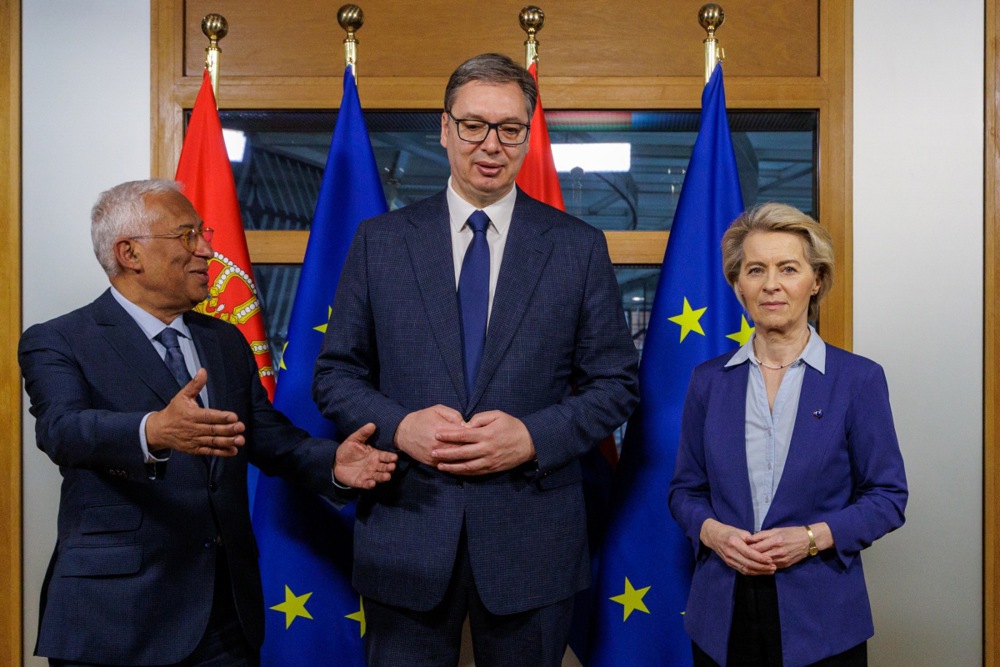
European Council President Antonio Costa, President of Serbia Aleksandar Vucic, and Commission President Ursula von der Leyen, Brussels, 25 March 2025. @EPA-EFE/OLIVIER MATTHYS
Hence, the desire of the protesters to be heard not only in Strasbourg, but by way of echo in places like Brussels or Paris. The bikers said it themselves, on the website specially created for this journey: “This trip is more than a bike tour – it’s a journey of hope, of resistance, and of the voices of those who have been [forever] silenced. That’s why we ride to Strasbourg. Not because we want someone else to fix our problems, but to ensure that the world will hear what’s happening in Serbia.”
The “Tour to Strasbourg” was just the latest in a string of ever more imaginative student actions that have rallied what seems to be the largest – and increasingly vocal – part of the Serbian society behind the protests.
A father’s advice to his student son: “Go and be naughty!” From Pumpaj! to the Student Edict
When I was a university student in Belgrade in those merry times of the mid-nineties, coping with the international economic sanctions on the one hand and protesting on the streets against the regime of Slobodan Milošević on the other, my dad used to tell me on my way out: “Go and be naughty!” This sentence may appear strange to an unsuspecting eye – for what kind of a parent tells his child not to behave nicely? But what it actually conveys is to enjoy my time coupled with a subtle advice to be careful.
He still uses the same phrase but now it’s reserved for his grandchildren. Two of them are currently engaged in daily blockades of their schools for weeks and months together with their schoolmates and teachers in support of the student demands.
In the eyes of the government, the young women and men at the helm of the protests are, to put it mildly, naughty. Their “naughtiness” consists of challenging the system, but also of spreading the news of injustice and repression in Serbia to the European students and citizens. I’m a father myself now and I say that if such motives irritate the corrupt regime and are therefore seen as naughty – than, by God, let’s all misbehave!
According to the data from the independent organization CRTA (Centre for Research, Transparency and Accountability), in the month of March alone there were at least 1.697 protests in 378 different places in Serbia. And in the first week of April there were at least 452 protests and 128 gatherings. Based on their surveys, the students have an 80 percent support in the public.
In that number of daily protests, there were at least six really big ones. And when I say big, I mean tens of thousands to hundreds of thousands of people walking on the thin line between celebrating togetherness and the newly found spirit of solidarity, on the one hand, and the feeling of fury and disgust at the regime and everything they represent, on the other. Those big ones were, till now, all held in one of the four university cities in Serbia: Belgrade and Novi Sad in the north, Niš and Kragujevac in the south of the country.
My family and I didn’t miss any of the big ones and I can’t tell the number of the smaller or local protests we’ve attended in the past several months. Every one of those big ones brought something special. Like that first major one in the evening of December 2024, only a month after the tragedy, on Slavija Square in Belgrade when 100,000 people kept perfect silence for fifteen minutes. Or the massive one that closed the main interchange in Belgrade for 24 hours this January. Or the next one in Novi Sad on February 1, commemorating three months from the tragedy, when groups of tireless students first started marching across the country. And they’re still doing that, walking to small towns and villages, putting up their small tables on a square with a banner Ask the student. They’re doing what the opposition parties should have done long time ago: talk to the people face to face, explaining what’s going on in the big cities, what the students really demand from the government, or why and how the media is lying to them. They say it’s an action of awakening. I’d be so bold to add that in the same time they’re removing the fear or its illusion.
On the next big protest, fifteen days after Novi Sad, this time in the city of Kragujevac, a new and the most beloved slogan was born. It's quite short: Pumpaj (pron. poompay), in translation: Pump it up, or pump up the pressure, don't lose heart! It's been the most uttered word from then onwards, surpassing good morning neighbour, good night dear, sleep tight my love, or even (hold to your chairs!) the official evening report about the activities of the President. I myself have shouted pumpaj! at least several hundred times, and counting.
My favourite protest was in Niš, on March 1, fifteen days after Kragujevac and four months from the train station tragedy. As in Novi Sad a month earlier, people from all over Serbia, myself and my family included, descended on Niš.
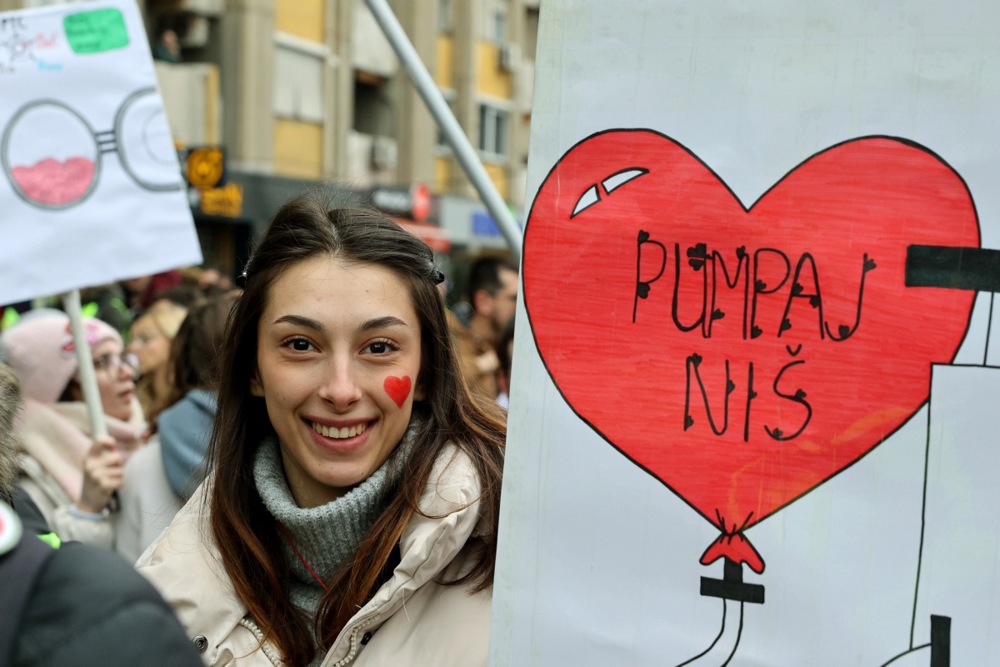
A protester holds a banner reading 'Pump it, Nis' during a student-led protest in Nis, Serbia, 01 March 2025 @EPA-EFE/DJORDJE SAVIC
Students of the local university composed for the occasion a paper they called The Student Edict. Its name was inspired by the Edict of Milan from the year 313 which gave Christianity legal status within the Roman Empire. The parallel has nothing to do with religion itself but with the mere fact that emperor Constantine the Great, who issued this decree, was born in what is now Niš (Naissus during Roman Times) and that the student edict spreads ideas of tolerance among people as well.
The Student Edict lists the values they are fighting for, among which are freedom, the rule of law, dignity, and solidarity.
“The avant-garde for the whole of Europe”: from Budapest to Munich, people lined up to welcome the protesting cyclists
As the eighty students that started on their way from Novi Sad cycled across Europe, the whole country followed their progress day by day via only a few independent media outlets and social networks. Every leg of their journey took them around 100 kilometres closer to their destination. At the end of each stage, they were welcomed by both Serbs living abroad and the locals. The usual student accommodation when marching from town to town in Serbia has mostly been on the faculties of their fellow students or in school gyms. After they crossed the border, the lodging became more intimate, so to speak, as Serbs living on their route took them as their personal guests.
In Budapest, among the hundreds of Serbs and Magyars welcoming the cyclists on the central Heroes' Square is the city mayor, Gergely Karácsony. He is one of the leading opposition figures to the populist prime minister Viktor Orbán, who’s been criticised for years both in Brussels and by the Hungarian opposition for the same reasons as Vučić: democratic backsliding and cooperating with Russia. Karácsony, who calls Budapest “an island of freedom”, as most of Hungary is dominated by Orbán’s Fidesz party, wrote after welcoming the students that “it was a touching and uplifting feeling to be with them at the Heroes’ Square – they are the real heroes who set an example for us all!”
Whilst the cyclists were being welcomed in central Budapest, the blinds on the nearby Serbian embassy were firmly shut…
In Vienna – a city with one of the largest and oldest Serbian communities in the world – when the cyclists entered the Maria-Theresien-Platz and rode onto the red carpet that was rolled out for them in the street, an otherwise normal and quiet Viennese evening turned into a celebration.
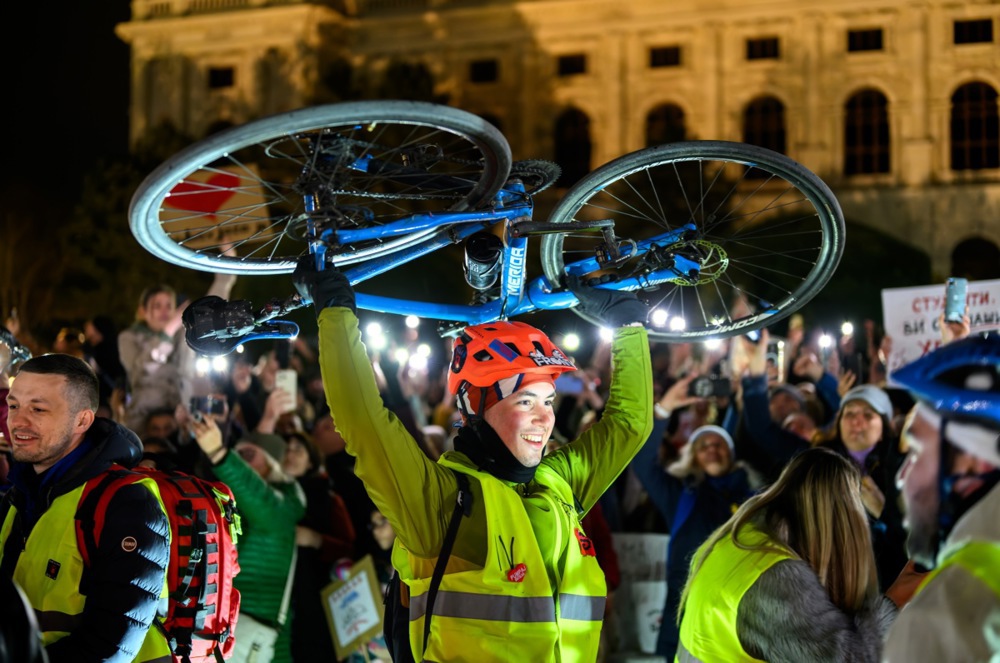
Serbian students celebrate as they arrive in Vienna, Austria, 07 April 2025 @EPA-EFE/MAX SLOVENCIK
Munich was even crazier than Vienna. Unlike the church authorities in Serbia, who have long since supported all nationalistic governments including the current one, the Serbian Orthodox Church in Germany has showed not only hospitality but an understanding for the ethical, emotional, and social motives of the students of Serbia. Bishop Grigorije – who is serving as the head of the Eparchy of Düsseldorf and all of Germany, and was a participant of the 1991 protests against Slobodan Milošević before deciding to take up the priesthood – prepared dinner for the student-bikers and arranged accommodations in church facilities for most of their stays from Munich to Strasbourg. “I am happy that we can host students in Munich, tomorrow in Augsburg, Stuttgart and the city of Karlsruhe. If we could be with them every second, it would be a great honour for us,” he said and added that students from Serbia “are, to put it simply, the avant-garde not only for Serbia, but for the whole of Europe” because “their courage springs from their love for justice, their desire for freedom and their fight for what is called democracy in the true sense of the word. The way they fight is sublime and magnificent.”
The largest protest in Serbia’s history took place despite the government’s best efforts to derail it
The largest protest since the tragedy in Novi Sad – and indeed, the largest protest in Serbia’s history – took place in Belgrade on Saturday March 15. The choice of the city was no mistake, for the students called literally everybody to join. Hundreds of thousands answered their call, coming from all over Serbia, despite the governments’ best efforts to stop them. The train lines connecting Belgrade and Novi Sad were shut down by the authorities on Friday, because of an alleged bomb threat. The regular intercity bus lines between Belgrade and the larger cities in Serbia were suddenly cancelled. The public transportation inside Belgrade was ordered to stop working from Saturday morning. Sudden traffic jams on highways and “regular” traffic control on other roads slowed down all those that headed for Belgrade.
On Friday, the day before the protest, thousands of students travelling on foot – some for 200 kilometres over a six-day period – reached Belgrade from all sides, with welcoming crowds cheering for them at the gates of the city. My family and I were standing on the northern gate in the crowd on the Main Street in Zemun. I met some neighbours, three librarians from our local library, and several parents from our kids’ schools. And when the students finally got there, we all pumped and humped and screamed and shouted and hugged with those young and brave people. Reuters, Times and Sunday Times live streamed the arrival of the students to Belgrade on their YouTube channels, whilst RTS (the Serbian national television and radio station), financed with the money of Serbian citizens, remained silent.
The next day, when the actual protest took place, there were probably around 325,000 protesters roaming around the city, according to the independent Archive of Public Protests (Arhiv javnih protesta). This doesn’t include local protests in the suburbs and in other parts of the country that were organized at the same time. The government came up with a much more conservative estimate of a little more than 100,000 protesters, and that figure was reported by some foreign media as well, to the disdain of some of those following the news while they were on the streets. As someone I overhead in the crowd put it: “Sure, maybe in one boulevard!”
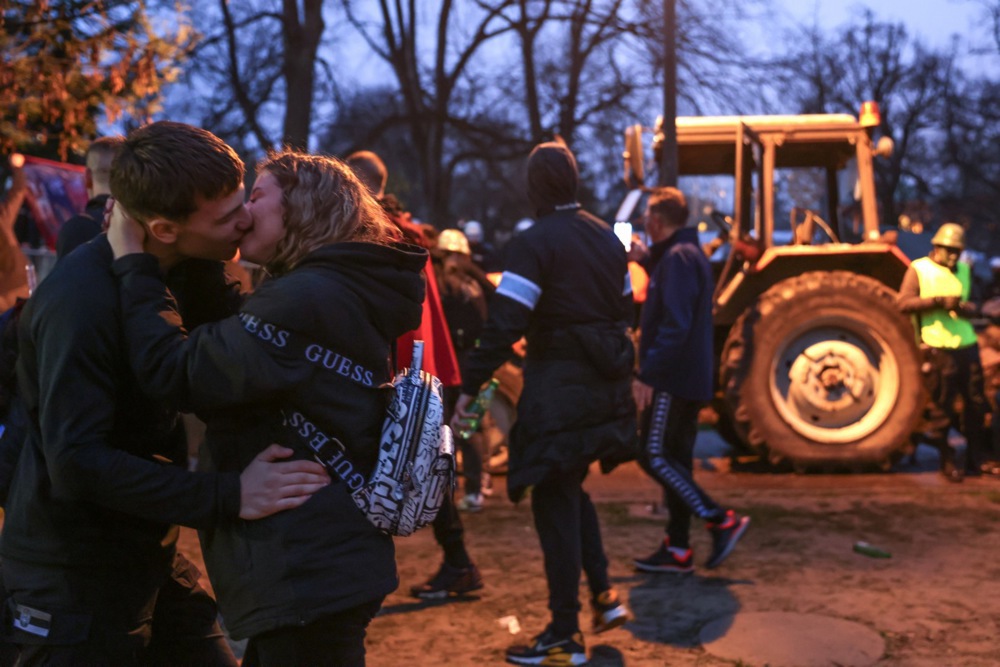
A couple kiss each other during the student-led rally in Belgrade, Serbia, 15 March 2025 @EPA-EFE/ANDREJ CUKIC
Getting to the protest was an adventure for itself. It took us more than two hours to reach the city centre. When we finally got there, we were greeted by the sound of thousands of voices, of people trumpeting and whistling and shouting and crying their eyes out! I wanted to say “There’s no need to shout, man, I can hear you!” There were thousands of banners, ground shaking music, funny hats, funny heads, umbrellas, more umbrellas, all the colours in a rainbow, all the rhythms in a brass orchestra, chirping birds, howling wolves, dialects and languages flying around like butterflies, carried by the wind, more umbrellas (“but the rain don’t fall anymore!”), and only one common thought in all those hairy heads: bring out the Good already, down with the Bad, even if it gets Ugly!
The Belgrade students of the Faculty of Fine Arts and the Faculty of Political Sciences presented their joint project to the crowd by pulling a three-meter-high Trojan horse in front of the Parliament building. As in the Iliad, there was a secret compartment inside the horse. But unlike in Homer’s epic more than three thousand years prior to this event, the students’ horse didn’t conceal warriors armed to the teeth but merely a short paragraph taken from the Serbian constitution:
Article 2, para 2.
“No state body, political organization, group or individual can usurp sovereignty from the citizens, nor establish power beyond the freely expressed will of the citizens."
And on the other side of the paper they wrote: "Citizens are the bearers of sovereignty!"
The legend says that there were thirty warriors inside the hollow horse of Troy led by Odysseus. I noticed that there are exactly the same number of words in the students’ message to the usurpers of justice in these lands of ours.
Pumpaj!
The “ominous sound”: did the government deploy a sound weapon against protesters?
The students that embarked on the “Tour to Strasbourg” were also determined to ask for a detailed investigation on the phenomenon that caused fear and panic at the March 15 Belgrade protest. It happened along the King Milan Street, exactly in the twelfth minute of what has become during the last five months an institution in its own right – keeping sixteen minutes of silence, one for each of the Novi Sad victims.
At 7.11 p.m. everybody who stood in silence in that street felt something. Some said that it was as if a plane was flying two meters above their heads. Or that an invisible bus was rushing down the street. Some heard a "whoosh" that made them think of Formula 1, or the ominous sound of an approaching missile, or a stampede of thousand horses...
Many among the people affected by the mysterious sound still have psychological issues they developed after experiencing that feeling of fear of the unknown force that wants to tear them apart. People who have pacemakers or other heart devices had serious health issues.
Activist groups collected and reported to the UN thousands of testimonies from the people who experienced the phenomenon. On the other hand, the Prosecutor's Office in Belgrade started taking their statements only twenty days after the actual incident, which only serves to demonstrate the validity of the student demands to liberate the state institutions from the destructive influence of a corrupt regime.
Several days later, the students of the Faculty of Dramatic Arts, from whence the blockade first started to spread, made a short documentary called “The Twelfth Minute”.
Also, in the span of two weeks, 4500 professors from all over the world, including Thomas Piketty, Annie Ernaux, Francis Fukuyama, Slavoj Žižek, Nancy Fraser, Étienne Balibar, Judith Butler, signed a document demanding an investigation into the use of a sound weapon in Belgrade.
The Dawning of the Age of Aquarius
These days the students on all universities are deciding about turning the protest political, so to speak. Something that many of their supporters were hoping for: the formation of a temporary expert government whose main tasks would be to meet the students’ demands and change the electoral conditions in such a way as to make the democratic elections possible (emphasis on democratic).
When commenting on the current situation, political analysts like to say that days ahead will be interesting. Of course, the word interesting could mean many different things, like: If all democratic groups don’t unite into one front ASAP the repression could soon go nuts. But in the same time, it could mean that Pluto leaves Capricorn and enters Aquarius, marking a time of collective awakening – or at least that’s what the hippies thought during a previous Age of Aquarius. In other words, God knows, whatever will be will be, que sera sera, and so on.
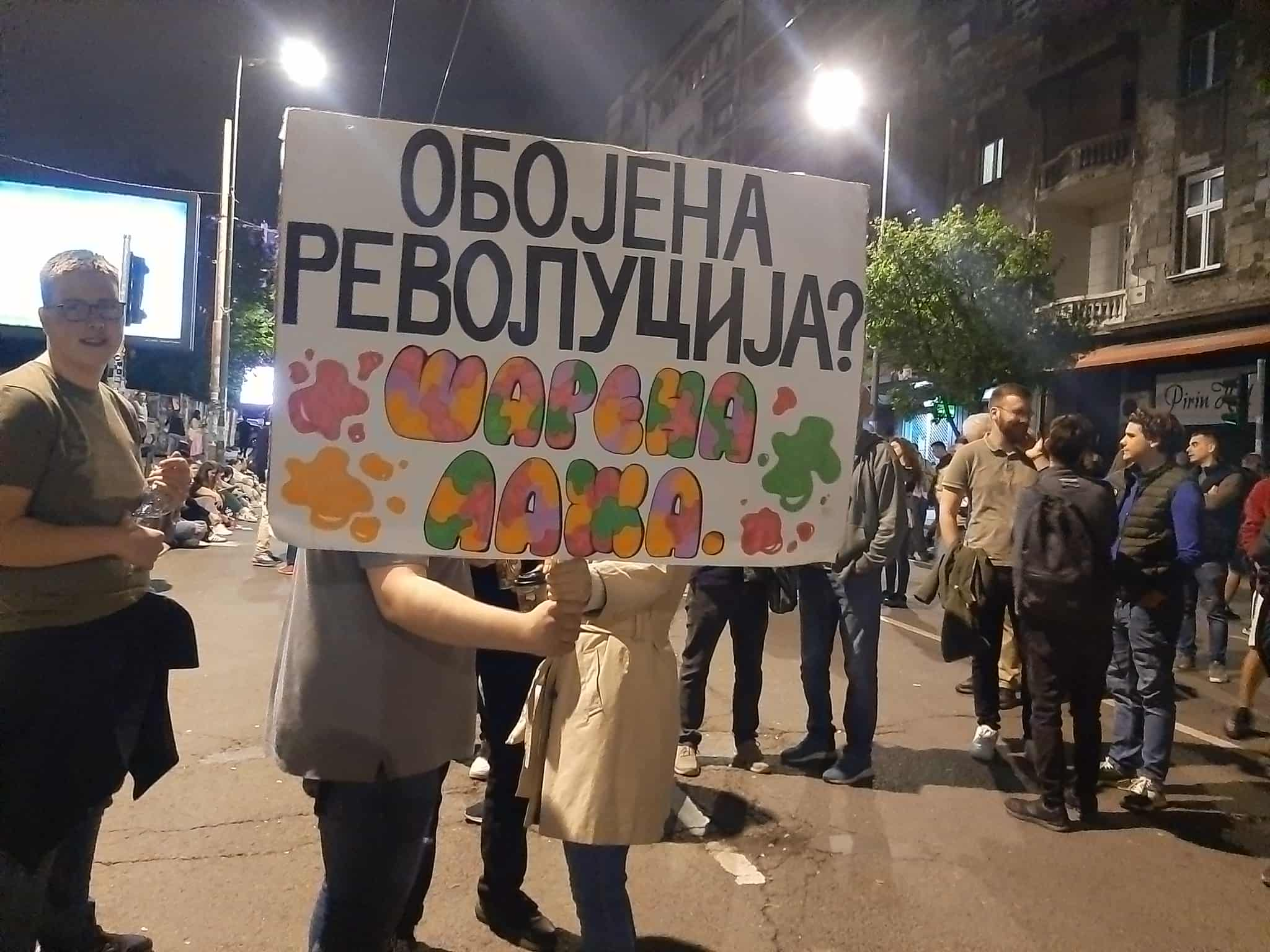
@Vrsan Leštarić
There’s another interesting thing that falls to my mind, though. The students already showed us that there are ways out of the apathy we’ve been imprisoned in. They constantly remind us of how good it feels to be able to rely on each other, to be tolerant to beliefs that are miles away from yours, and to openly show sympathy and love for each other. If only for that we remain forever grateful to them. Or in the words of Jiddu Krishnamurti: “Love can do nothing but without it nothing can be done.” So, go and be naughty!


